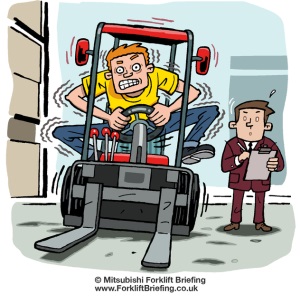Complete Powerpoint slide presentation for forklift instructors. Ready made training course
why forklift operators could be feeling the impact of whole body vibration
 This article is by Mitsubishi forklift trucks and talks about the problems of whole body vibrations often felt by forklift operators.
This article is by Mitsubishi forklift trucks and talks about the problems of whole body vibrations often felt by forklift operators.
What is Whole-Body Vibration?
Whole-Body Vibration (WBV), as the name suggests, involves mechanical vibrations travelling through the operator’s entire body — usually via the feet or the truck seat. While these vibrations are inherent to the nature of the job, their prolonged exposure can lead to various health issues.
Though not always the sole cause, studies have found a significant link between WBV and lower back pain when experienced over extended periods, and it can further aggravate existing conditions.
The lumbar region bears the brunt of the stress from WBV, leading to muscle strain, spinal disc compression, and a heightened risk of chronic musculoskeletal disorders.
The UK’s Health and Safety Executive estimates that more than 5 million working days are lost each year due to back pain that is either a direct result of work, or pain that has been exacerbated by work.
The vibrations themselves come from a combination of the working environment and the truck itself, and both the severity of the vibration and the length of exposure determine their effects.
Driving over uneven floors or on potholed surfaces can lead to particularly heavy vibrations and jolts, which are more likely to have a larger individual impact.
Constant exposure to WBV can also induce whole-body fatigue, affecting the overall well-being and productivity of operators. Diminished concentration, delayed reaction times, and increased error rates become potential consequences, compromising workplace safety and efficiency.
So what can you do to lessen the impact?
With counterbalance trucks, one of the main factors is the power source. Internal combustion engine trucks by their very nature have greater vibration levels than electric trucks. And many modern electric trucks go even further to reduce this level, with integration of cutting-edge ergonomic features into their designs, including specialised seats and advanced suspension systems.
For example, features like a rubber-mounted cabin can minimise the effect of microvibrations on the operator.
And in the warehouse where there may be long, repetitive shifts, it is important to have equipment that stays as smooth and steady as possible.
Features like adjustable ride platforms, where the damping can be set based on the operator's weight, not only make the job more comfortable but also help things run more smoothly and safely. Combined with systems that maximise traction and load stability, and the impact on your staff will be greatly reduced.
Regular maintenance and inspection of your forklifts are essential to ensure that they run efficiently and minimise excessive vibrations as some may be caused by mechanical issues.
Comprehensive training initiatives will help to equip forklift operators with the knowledge and techniques — including maintaining correct posture — necessary to ease WBV-related risks.
Implementing a rotation system for forklift operators can help distribute the workload and reduce prolonged exposure to vibrations.
Operators should be encouraged to take regular breaks to alleviate muscle tension and fatigue. Scheduling regular rest breaks allows operators to recover and minimise the risk of developing musculoskeletal issues.
Addressing the effects of Whole-Body Vibration on forklift drivers is crucial for ensuring their health, safety, and overall well-being. By investing in ergonomic equipment, ensuring surfaces are well maintained, providing training, and scheduling regular breaks, businesses can mitigate the risks associated with WBV exposure.
ACTIONS:
Assess the ground and floors at your worksite for potholes or other uneven surfaces
Look at the speed limits on site —higher speeds often lead to an increase in vibration
Consider trucks with advanced damping systems
Consider switching to electric counterbalance trucks if you are using IC engine trucks
Disclaimer. The legislative information contained on this web site is my interpretation of the law based on many years in the health and safety business. A definitive interpretation can only be given by the courts. I will therefore not be held responsible for any accident/incident/prosecution arising as a consequence of anyone using any information obtained from this web site.